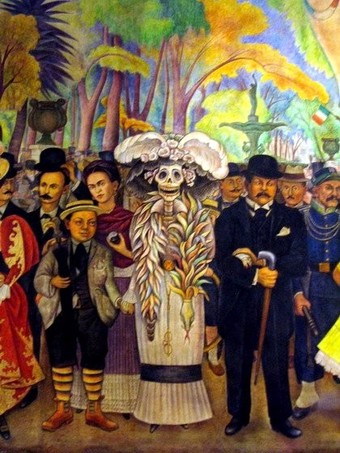36.1.5: Art and Culture in 20th-Century Mexico
The Mexican Modernist School used large-scale murals to reinforce political messages, especially those that emphasized Mexican rather than European themes.
Learning Objective
Give examples of major works of art in Mexico during the 20th century
Key Points
- The Mexican Revolution had a dramatic effect on Mexican art, and the Mexican government commissioned murals for public buildings to reinforce political messages, especially those that emphasized Mexican rather than European themes.
- The Mexican muralist movement reached its height in the 1930s with four main artists: Diego Rivera, David Alfaro Siqueiros, Jose Clemente Orozco,and Fernando Leal. It is now the most studied aspect of Mexico’s art history.
- Diego Rivera’s murals were greatly influenced by his leftist political leanings, dealing with Mexican society and reflecting the country’s 1910 Revolution.
- Frida Kahlo de Rivera was a Mexican painter known for her self-portraits. Though she painted canvases instead of murals, she is still considered part of the Mexican Modernist School due to the emphasis of Mexican folk culture and use of color in her works.
Key Terms
- Mexican Modernist School
- The artistic movement within Mexico that was especially prolific in the 1930s, glorifying the Mexican Revolution and redefining the Mexican people vis-à-vis their indigenous and colonial past. Large-scale murals were its preferred medium.
- surrealist
- A cultural and artistic movement that mixed dream and reality into one composition.
Mexican Muralism and Revolutionary Art
The Mexican Revolution had a dramatic effect on Mexican art. The government allied itself with intellectuals and artists in Mexico City and commissioned murals for public buildings to reinforce political messages, especially those that emphasized Mexican rather than European themes. The production of art in conjunction with government propaganda is known as the Mexican Modernist School, or the Mexican Muralist Movement. Many such works glorified the Mexican Revolution or redefined the Mexican people vis-à-vis their indigenous and colonial past. The first of these commissioned works was done by Fernando Leal, Fermin Revueltas, David Alfaro Siqueiros, and Diego Rivera at San Ildefonso, a prestigious Jesuit boarding school.
The muralist movement reached its height in the 1930s with four main artists: Diego Rivera, David Alfaro Siqueiros, Jose Clemente Orozco, and Fernando Leal. It is now the most studied aspect of Mexico’s art history. These four artists were trained in classical European techniques and many of their early works were imitations of then-fashionable European paintings styles. Many Mexican government buildings featured murals glorifying Mexico’s pre-Hispanic past and incorporating it into the definition of Mexican identity. Many of these muralists also revived the fresco technique in their mural work, although some like Siqueiros moved to industrial techniques and materials such as the application of pyroxilin, a commercial enamel used for airplanes and automobiles.
Diego Rivera
Rivera painted his first significant mural, Creation, in the Bolivar Auditorium of the National Preparatory School in Mexico City in January 1922 while guarding himself with a pistol against right-wing students. In the autumn of 1922, Rivera participated in the founding of the Revolutionary Union of Technical Workers, Painters and Sculptors, and later that year he joined the Mexican Communist Party. His murals were greatly influenced by his leftist political leanings, dealing with Mexican society and reflecting the country’s 1910 Revolution. He developed his own native style based on large, simplified figures and bold colors. A strong Aztec influence was present in his works, and much of his art emulated the Mayan steles of the classical era.

Mural by Diego Rivera: Mural Sueño de una Tarde Dominical en la Alameda Central in Mexico City, featuring Rivera and Frida Kahlo standing by La Calavera Catrina.
Frida Kahlo
Frida Kahlo de Rivera was a Mexican painter known for her self-portraits. While she painted canvases instead of murals, she is still considered part of the Mexican Modernist School due to the emphasis of Mexican folk culture and use of color in her works. She was married to muralist Diego Rivera and like Rivera was an active communist. Kahlo was influenced by indigenous Mexican culture as demonstrated by her use of bright colors, dramatic symbolism, and primitive style. She often included monkeys in her works; while this is usually a symbol of lust in Mexican mythology, Kahlo’s portrayal was tender and protective. Christian and Jewish themes were often depicted in Kahlo’s work. She combined elements of classic religious Mexican traditions with surrealist components in her paintings.

Frida Kahlo by Guillermo Kahlo: Kahlo in 1932, photographed by her father, Guillermo.
Attributions
- Art and Culture in 20th-Century Mexico
-
“Mexican art: 20th century.” https://en.wikipedia.org/wiki/Mexican_art#20th_century. Wikipedia CC BY-SA 3.0.
-
“San Ildefonso College.” https://en.wikipedia.org/wiki/San_Ildefonso_College. Wikipedia CC BY-SA 3.0.
-
“The_Kid_-_Diego_Rivera.jpg.” https://commons.wikimedia.org/wiki/File:The_Kid_-_Diego_Rivera.jpg. Wikimedia Commons CC BY-SA 2.0.
-
“Frida_Kahlo2C_by_Guillermo_Kahlo.jpg.” https://commons.wikimedia.org/wiki/File:Frida_Kahlo,_by_Guillermo_Kahlo.jpg. Wikimedia Commons Public domain.
-
Candela Citations
- Boundless World History. Authored by: Boundless. Located at: https://courses.lumenlearning.com/boundless-worldhistory/. License: CC BY: Attribution